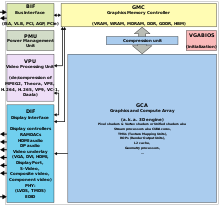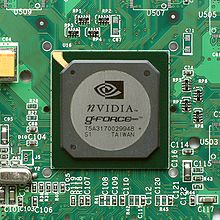Digital Media Concepts/Graphics processing unit

A graphics processing unit (GPU) is a specialized card designed specifically to be specialty logic chip for display functions. GPU's can be found in plug-in cards, in a chipset on the motherboard or in the same chip as the CPU. The GPU has a number of applications including the rendering of images, animations and videos for a computer's screen. GPU's are essential for rapid and smooth decoding and rendering of 3D animations and video. They are rapidly beginning to be used as vector processors for non-graphic applications as their often large processing power makes them useful for repetitive computations.[1]
Application
[edit | edit source]Graphics are data that must be processed and rendered onto a bitmap and then it is rendered onto the computer's screen. Each possible color or shade that could be rendered requires atleast one bit of information. Meaning if a screen is simply black and white, each pixel will only require one byte of information. With each frame requiring so much information to be processed quickly Graphic Processing Units can specifically do this process using its own processing power taking the load off the processor. [2]
GPU's are sometimes utilized to mine cryptocurrencies that use blockchain technologies.
Early History
[edit | edit source]Before Graphics Processing Units were developed often computer's would either use the processing power of the CPU which for complex computations it would require highly expensive processors or a unique workaround developed for specific machines. Examples below.
Atari 2600
[edit | edit source]
The atari 2600 instead of using a dedicated video card, would cheat by using a monochrome background and two single-color sprites that was only large enough for a single horizontal line. To get more complex displays, the 2600 would continously write and rewrite the information for each line on the TV screen. It allowed the 2600 to render complex graphics without the use highly expensive extra RAM cards that could price the console somewhere in the 1,000's.
Nintendo SNES
[edit | edit source]
The Super Nintendo Entertainment System managed to keep a consistent framerate of 60fps while selling at a price tag of 200$. Nintendo accomplished this by dicing the pixels into tiles and tilemaps and sprites and palettes which were all composited together with no involvement from the underpowered 16-bit CPU.[3]
Initial Invention
[edit | edit source]
The Nvidia Geforce 256 was the first Graphic Processing Unit and was unveiled on august 31st, 1999. It boasted being the first 256-bit 3D processor, first integrated geometry transform engine, first integrated dynamic lighting engine, and the first four-pixel rendering pipeline. It revolutionized how computer graphics can be both rendered. Before the 256 the best graphics in the game's industry were games like DOOM, now with Graphic Processing units video games immediatly jumped into 3D rendered graphics with games like Quake.[4]
Forms of GPU's
[edit | edit source]On-Board
[edit | edit source]Usually found on board the PC in lieu of no expansion slot available. Found regularly on laptops and low-priced pre built computers.
PCI Express
[edit | edit source]Common Form usually found in modern external graphics cards. Found in different versions such as its latest PCI Express 3.0.
AGP
[edit | edit source]Commonly used in the mid 2000's but now defunct in most forms. The final AGP style unit was produced by ATI in 2008.
References
[edit | edit source]- ↑ "Definition of GPU". Retrieved 20 September 2017.
- ↑ F.Robert A. Hopgood; Roger J. Hubbold; David Duce. "Advanced Computer Graphics 2". Retrieved 20 September 2017.
- ↑ James Hague. "Why Do Dedicated Game Consoles Exist?". Retrieved 20 September 2017.
- ↑ "NVIDIA Launches the World's First Graphics Processing Unit: GeForce 256". Retrieved 20 September 2017.
- ↑ AJ Graham. "Types of Graphics Processing Units". Retrieved 26 September 2017.
